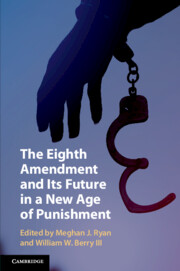Book contents
- The Eighth Amendment and Its Future in a New Age of Punishment
- The Eighth Amendment and Its Future in a New Age of Punishment
- Copyright page
- Dedication
- Contents
- Contributors
- Preface
- Introduction
- Part I A History of the Eighth Amendment
- Part II The Landscape of Eighth Amendment Doctrine
- Part III The Future of the Eighth Amendment
- 12 Judicial Abolition of the American Death Penalty under the Eighth Amendment: The Most Likely Path
- 13 Back to the Future with Execution Methods
- 14 Evolving Standards of Lethal Injection
- 15 The Future of Juvenile Life-Without-Parole Sentences
- 16 Metrics of Mayhem
- 17 Race Discrimination in Punishment
- 18 Science and the Eighth Amendment
- Index
16 - Metrics of Mayhem
Quantifying Capriciousness in Capital Cases
from Part III - The Future of the Eighth Amendment
Published online by Cambridge University Press: 03 June 2020
- The Eighth Amendment and Its Future in a New Age of Punishment
- The Eighth Amendment and Its Future in a New Age of Punishment
- Copyright page
- Dedication
- Contents
- Contributors
- Preface
- Introduction
- Part I A History of the Eighth Amendment
- Part II The Landscape of Eighth Amendment Doctrine
- Part III The Future of the Eighth Amendment
- 12 Judicial Abolition of the American Death Penalty under the Eighth Amendment: The Most Likely Path
- 13 Back to the Future with Execution Methods
- 14 Evolving Standards of Lethal Injection
- 15 The Future of Juvenile Life-Without-Parole Sentences
- 16 Metrics of Mayhem
- 17 Race Discrimination in Punishment
- 18 Science and the Eighth Amendment
- Index
Summary
Social science has figured prominently in debates over the constitutional administration of capital punishment for more than a half-century, especially with respect to capricious and biased decision-making. The Court’s ruling in Furman v. Georgia, responsible for ushering in the modern era of capital punishment by invalidating then-existing capital statutes as violative of the Eighth Amendment’s prohibition against cruel and unusual punishment, was replete with references to social scientific evidence documenting inconsistent, irrational, and discriminatory capital charging and sentencing practices. Furman contained the most extensive discussion of social science research in any decision up to that point, and all five Justices comprising the per curiam opinion in Furman agreed that evidence identifying the capricious imposition of the death penalty provided sufficient justification to impose an immediate moratorium on executions in the United States and then require the commutation of all death sentences for condemned inmates. Yet the weight given to this empirical evidence (or lack thereof) in judicial decision-making has, itself, been irrational and inconsistent.
- Type
- Chapter
- Information
- The Eighth Amendment and Its Future in a New Age of Punishment , pp. 266 - 282Publisher: Cambridge University PressPrint publication year: 2020

